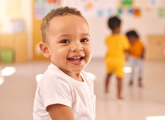Providing access to a range of instruments and genres can be a gateway to investigating different cultures, creatures and more, says Barbara Isaacs…
Music has always been a strong feature of Montessori education. Nursery rhymes and songs are part of the daily routine of most early years settings, and a vitally important aspect of language development for babies and toddlers. They are also the conduits for transmission of culture. With access to recordings on CDs and mobile phones, children can learn songs both modern and traditional from across the world, and access classical music.
These experiences contribute to children’s knowledge and understanding of the world, particularly if combined with other opportunities, such as tasting food from other cultures, celebrating festivals and learning about exotic animals and plants. Having children’s clothing from various countries in the dressing-up box, and learning dances from these countries further complements musical experiences and learning opportunities. Together, these elements develop children’s understanding of similarities and differences between peoples of different nations, helping to promote diversity and inclusion, and contributing to the process Montessori termed ‘becoming citizens of the world’.
At the start of the 20th century there was very little access to percussion instruments used by many nurseries today. Montessori started to use bells tuned to the scale of C; they’re still part of percussion in professional orchestras today. Each bell represents one note from middle C to high C. Each bell is provided with a striker and a damper, and children learn how to strike the bell and silence it. Today chime bars provide us with same opportunities the Montessori bells did a hundred years ago.
By providing children with two sets of these bells, they can match sounds and refine their sense of hearing. This basic pairing activity can be extended into building up the scale C in sequence and even trying to play a simple tune. Sadly the bells are rarely seen in Montessori nurseries today – mainly because of their cost, but also because they are more suited to the concentration and coordination levels associated with the skills of four to five-year-olds rather than the younger children attending Montessori nurseries in England today.
Many early years practitioners use recorded songs to support singing; others play an instrument such as a guitar to accompany their sessions. Some settings hire a professional musician to lead music sessions, to give children additional opportunities for learning about music, where pitch and rhythms as well as movement are incorporated into the activity.
However, as more young children attend Montessori daycare provision for babies and toddlers, we see much good practice in supporting language development through songs and rhymes, and in developing a sense of rhythm through dancing to all kinds of tunes.
Many settings use ‘music feely bags’ to help young ones choose a song to sing – e.g. finding a red bus, a small green bottle and a bell will signal the start of ‘The Wheels on the Bus’, ‘10 Green Bottles’ and ‘Jingle Bells’ respectively. Some settings also have a song chart, where objects are replaced by pictures representing the songs, and babies can point to a picture when indicating their preference.
Children can be introduced to a variety of musical instruments played by parents or friends of the nursery. These experiences may lead to a more structured study of the orchestra and its components, using pictures of the key sections such as strings, woodwind, brass or percussion. These pictures can accompany listening to pieces of music such as Britten’s ‘Young Person’s Guide to the Orchestra’ or Prokofiev’s ‘Peter and the Wolf’.
None of the activities I have suggested are unique to Montessori, of course, and having access to percussion instruments, a variety of songs on CD or iPad, and daily singing sessions should be part of the enabling environment in all settings.
Barbara Isaacs is the academic director of Montessori Centre International.

Dyspraxia – Is it hiding in plain sight in early years?
Editors picks
